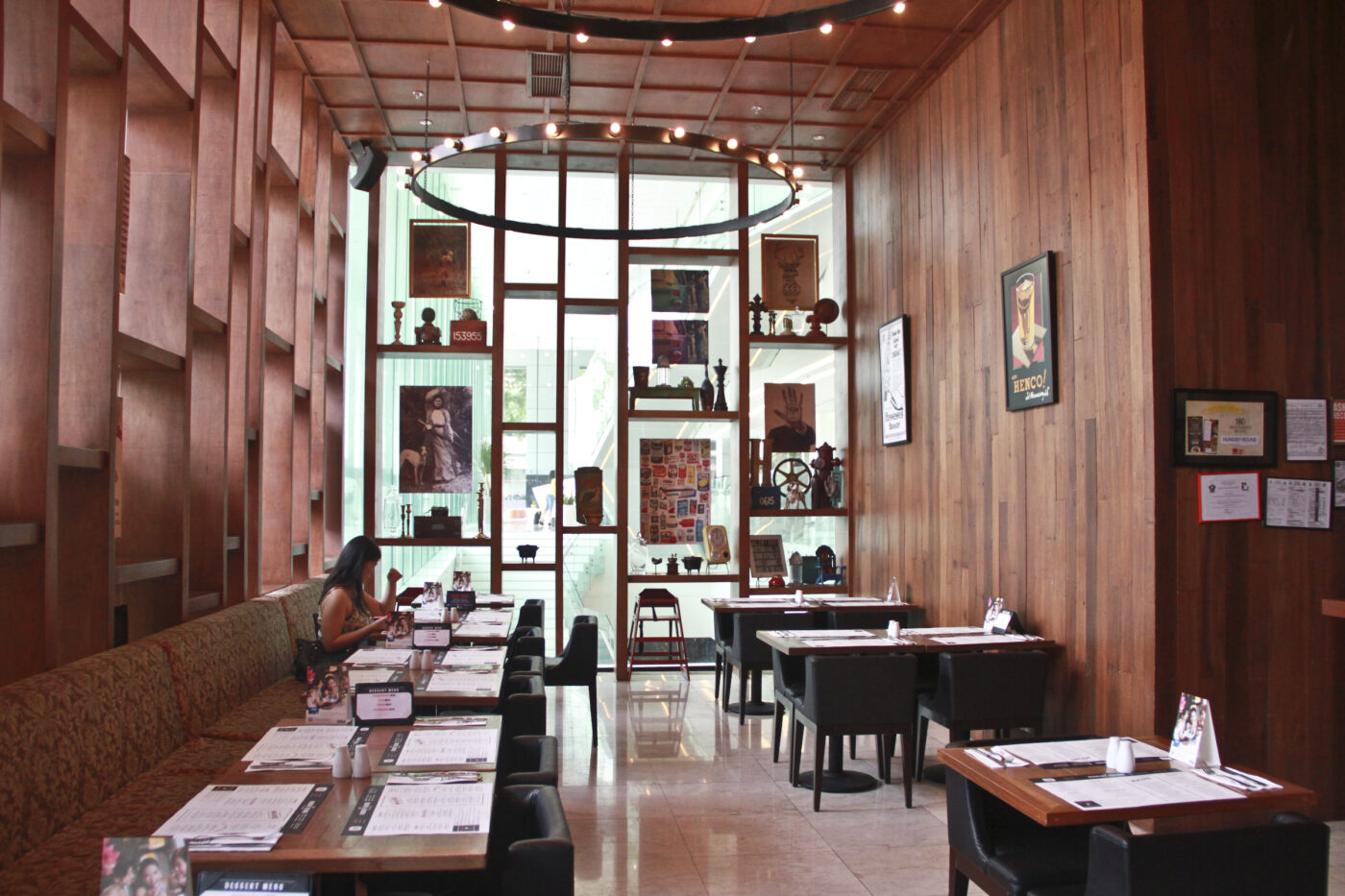Dim lights illuminate the dark wood walls. Wine glasses and beer mugs dangle from above. People sit in cozy booths, laughing and enjoying each other’s company. Casual and relaxed, the ambience of the gastropub can make anyone feel right at home.
Numerous foreign food trends have overwhelmed the Filipino food scene recently, with cronut cafés and ramen noodle houses cropping up on every corner. The gastropub is yet another addition to the diverse culinary landscape of the city, introducing our taste buds to a unique gastronomic experience.
As more restaurants like The Hungry Hound, The Tipsy Pig and Draft dot the Metro, gourmet dishes and craft beer are now served with ease and comfort. As opposed to the formal and stiff atmosphere of fine dining restaurants, the gastropub offers a refreshing change of scene.
Heussaff and the Hound
The gastropub began in the United Kingdom, where it naturally evolved from the traditional British pub. However, Erwan Heussaff, restaurateur and owner of The Hungry Hound in Bonifacio Global City, is quick to point out that the concept of the gastropub isn’t exclusive to the British. “In France, [the equivalent of] the pub was the brasserie, and then there was an evolution from the brasserieto–what we call the bistro, which has smaller plates, while still being based on the same style of comfort food,” he explains.
Unlike regular pubs, which capitalized on comfort, the first gastropubs aspired to go a step above by catering to a market characterized by more refined tastes. More thought was placed into the creation of the dishes, which typically came with a bigger price tag than those served at traditional pubs. Liquor is essential to both, although the gastropub placed more importance on how it paired with food.
The gastropub, Heussaff admits, is a term often misunderstood, especially in the local restaurant scene. “You have every other restaurant opening and calling themselves gastropubs, then what they usually do is that they put fish and chips and some sort of pie on the menu and they think that they fit the realms of the concept.”
While these dishes are the hallmark of the gastropub, The Hungry Hound has its own unique take on such classics. For instance, battered fish soaked in Chimay beer and duck fat fries coated in sweet paprika stand in for the usual fish and chips. Slivers of puff pastry and medium-well hanger steak, with a purée of peas and Chimay au jus, make up a deconstructed steak and ale pie.
He credits this lack of depth to the industry’s heavy dependence on foreign trends. “People seem to tailgate each other in terms of concept,” he says, “but you can’t just see something on the Internet, try it once, and say, ‘Okay, let’s bring it here.’” To avoid this, Heussaff patterns The Hungry Hound after the original British gastropub, which was meant to appeal to the everyman while still maintaining a flavor of elegance.
With its high ceiling, modern wooden interiors and subtle lighting, elegant is a good way to describe the vibe of The Hungry Hound, which can be found in the Globe Tower. The brainchild of the building owners and a team of restaurateurs, it is meant to appeal to all Globe employees, from the lower to the higher management. Filipinos generally have no qualms about mixing business and pleasure, especially when eating out, but Heussaff notes that “it’s also very ironic that people don’t want to go out and drink where they eat.”
He believes that when Filipinos dine and drink, they prefer to go to places that are laidback and don’t require them to dress to impress. “That’s why you have places like Opus that never did well,” he adds, mentioning the supper club that closed earlier this year; because it was successful as a drinking place, it never really seemed to click as a dining place. In contrast, the gastropub just might be the perfect fit for the cosmopolitan Filipino, as it makes going out “a casual yet trendy affair.”
Food for thought
The advantage of the gastropub lies in its specific niche: While it is meant to appeal to the casual diner, its elevation from the original pub allows the chef to be more ambitious. For instance, The Hungry Hound’s chef, Mikko Reyes, creates and executes an artisanal gastropub menu every week.
“The gastropub concept allows you to do things that are a bit more cerebral, things that wouldn’t really fit with other casual eateries,” says Heussaff. Their artisanal menu is crafted depending on what’s fresh, what’s on the market, what’s seasonal and what goes well with alcohol. Different techniques like sous vide—a method of cooking food sealed in plastic bags and submerged in boiling water—are also used from time to time.[blockquote author=”Erwan Heussaff, Owner, The Hungry Hound” pull=”pullright”]The gastropub concept allows you to do things that are a bit more cerebral, things that wouldn’t really fit with other casual eateries[/blockquote]
Another important aspect Philippine gastropubs consider is the local beer. Other than the standard San Miguel beers, some gastropubs also have local craft beers on tap, such as Katipunan Craft Ale and Fat Pauly’s. JJ Yulo, a contributing editor at Rogue and the founder of Pinoy Eats World, a catering company geared towards local food culture, thinks that this is necessary. “Everyone’s like, ‘Oh! I’ve tried this Dutch beer.’ There’s nothing wrong with that, but give props to the local guys, because there are some really good beers coming along,” he says
The Perfect Pint, a gastropub that opened just this year, does just this by offering local ales. In a Pepper article, Managing Editor Mikka Wee also attests to its perfect pairs, which consist of combinations of home-brewed craft beers and gourmet food designed by chef Gene Gonzales. “They also know what they’re talking about, explaining why this beer goes with that dish, so you won’t have to blindly guess why they go together,” Wee writes.
The Perfect Pint’s menu includes items like freshly baked caramel brownie s’mores with rum raisin ice cream. Gonzales recommends customers eat them with a cold glass of Fat Pauly’s Amapola, a local brewery’s take on the dark chocolate ale, or a Czech beer like Pivo Dark Pilsner. Another excellent pairing is the Stinky 5 Cheese pizza, coupled with the foamy and light Pivo Weizen.
Legen—wait for it—dary
With its traditional Irish pub concept, wide drink selection, conventional pub food and cozy booths, MacLaren’s was Ted and the gang’s favorite haunt. Even after the final episode, the image of the How I Met Your Mother (HIMYM) cast hanging out at this pub remains iconic. Although it may not have strictly been a gastropub, it did succeed in presenting the environment that gastropubs aspire to create: A casual place where great food and drinks are served and lasting memories are made.
Before gastropubs made their way to Manila, traditional pubs like the San Mig Pub in Alabang Town Center were already drawing crowds in as early as the 80s. Similar to HIMYM’s MacLaren’s, the young and the old made a lot of great memories in places like these. “There’s a legacy, and people love it. Now, I guess, there’s nothing like that anymore,” says Yulo.
But when asked about whether gastropubs could possibly become a mainstay, Yulo answers in the affirmative. “Absolutely, as long as they care about it,” he says. “It’s just a matter of caring about putting out the food consistently, understanding your customers and what [they] want.”
Heussaff adds to this, saying, “The difference I see in restaurants that go further and survive better is that, instead of good service, I would say [they have] good personality.” Beyond the services that trained busboys and waitresses offer, the restaurant itself comes to life.
This personality is breathed into the restaurant by the architecture, the menu, the restaurateur and, most importantly, by the people that come over. Filipinos, according to Heussaff, are also very social eaters in contrast to Westerners. Even if the food and drinks are great, the meal never seems to be complete without great company.
Whether or not this trend will make it big and last for generations to come, it certainly has the attention of Filipino restaurateurs looking to set up shop right now. Gastropubs are definitely making their presence felt by shaking up the Manila food scene. They not only offer something different to tingle taste buds, but also a sense of familiarity that keeps customers coming back.
Updated: Aug. 24, 2014, 9:45 PM








